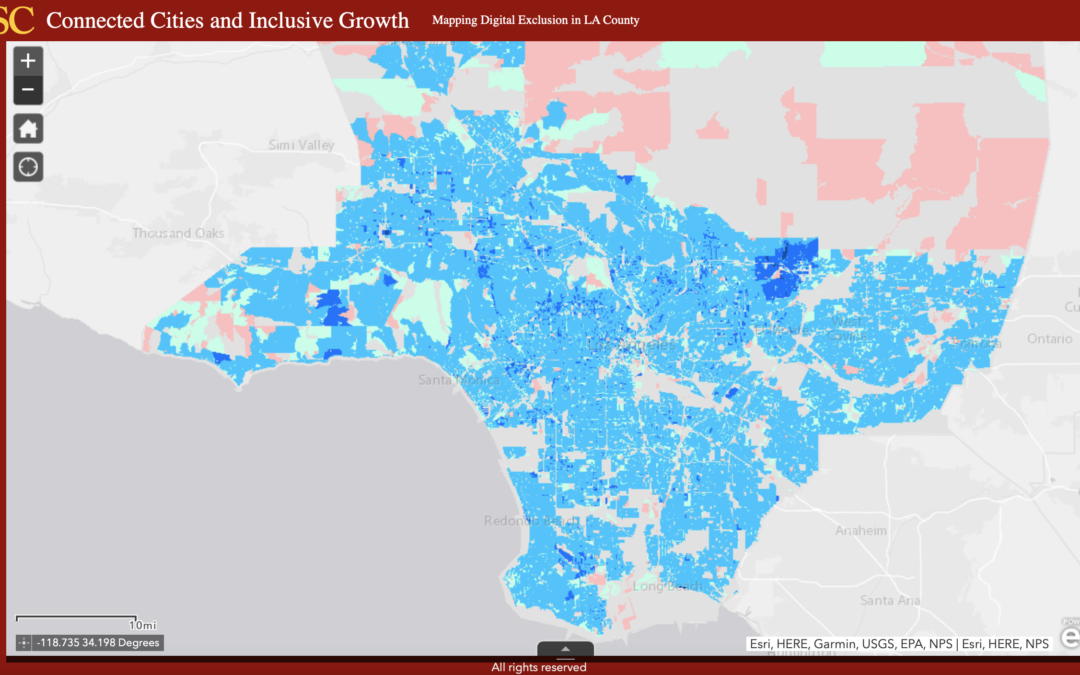Mapping the Digital Divide in LA
For years, researchers at the USC Annenberg School for Communication and Journalism (USC Annenberg) have been working to illustrate the digital divide that exists in Southern California so that, armed with the information, we can take steps towards curing the inequity. In 2017, USC’s Connected Communities and Inclusive Growth (CCIG) project launched the “Mapping the Digital Divide in LA” initiative which compiles the most recent broadband deployment and adoption data into an easy-to-use interactive map. Local governments–including the City of Los Angeles and the City of Long Beach–and community organizations have turned to the valuable map when constructing their own programs and initiatives. Cited by the Los Angeles Times, the Los Angeles County Office of Education, and other reputable institutions, USC Annenberg’s CCIG project is one of the premier sources of information available in the fight against digital inequity, and now it’s ready for statewide expansion.
Expanding Across California
We’ve awarded a Michelson Spark Grant to USC Annenberg, which will enable them to expand their CCIG project from LA County to the entirety of the country’s most populous state. This new phase will be spearheaded by Professor Hernan Galperin, internationally recognized expert on Internet policy and digital inequality. Professor Galperin’s research uses surveys, field experiments and other quantitative methods to understand how a lack of broadband internet adversely affects communities.
The newest iteration of the CCIG project will:
- Expand the thematic scope of the work to include other data sources such as measurements of digital literacy and actual broadband speeds (as opposed to currently reported advertised speeds).
- Expand the platform interface to include heatmaps and other visualization functionalities.
- Expand the geographical granularity of the data from census block-level data reporting to addressed-based data reporting.
- Expand the current analysis of residential broadband availability and individual use to include connectivity at schools, libraries, and community centers as well as by small businesses.
- Expand USC Annenberg’s ability to respond to specific requests for data and analysis by local policymakers and practitioners.
- Expand the visibility and use of the platform by third parties through training seminars and other outreach activities.
The Potential to Vastly Scale Impact
The scaleable CCIG platform allows for new data layers to be added, such as updates to existing sources that enables users to compare data across timeframes. This scalability is also possible at different levels of geographical disaggregation. For example, once the Federal Communications Commission completes the transition from census block level data reporting to address-level reporting, the new data can be added to provide more granular analysis of broadband access and speeds. So far, government agencies and digital equity advocacy organizations have made great use of the interactive map. Michelson 20MM will continue to help inform the digital equity conversation through the CCIG project, and we hope that the data surfaced will promote sound policy solutions for all California residents.
The Michelson 20MM Foundation is dedicated to supporting and investing in leading organizations, technologies, and initiatives that seek to transform learning and improve access to educational opportunities that lead to a meaningful career. Michelson 20MM was founded thanks to the generous support of renowned spinal surgeon and inventor Dr. Gary K. Michelson and his wife, Alya Michelson. Visit us at 20mm.org.
